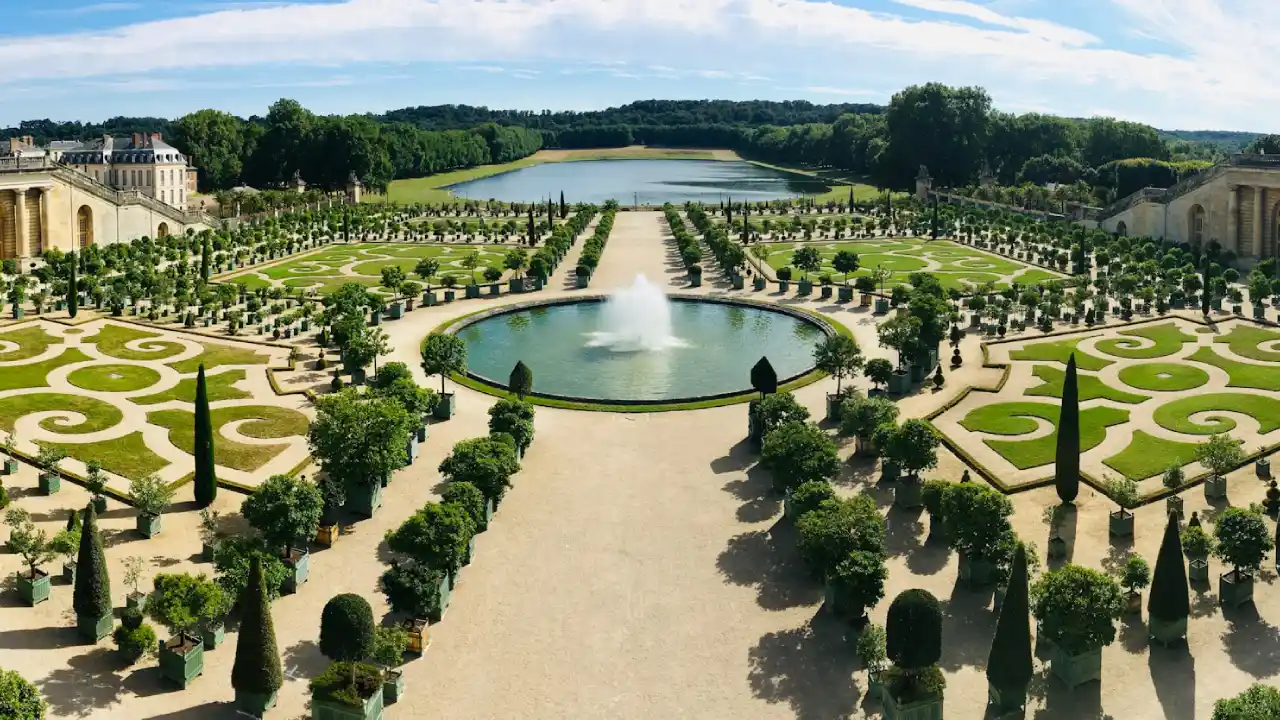
Customer support to help you with everything you need from 8.00 a.m. to 6.00 p.m.

Choose the best option for your needs and preferences and avoid the lines booking here

Enjoy art and history in Versailles, French monarchy’s masterpiece

The Palace of Versailles stands as a monumental example of French Baroque architecture and one of the most extravagant palaces ever built. Its intricate design, expansive gardens, and opulent interior decoration have made it a symbol of the absolute monarchy of the Ancien Régime and a UNESCO World Heritage site. This article delves into the architectural features of Versailles, describes the palace’s overall aesthetic, explores the unique Versailles style, and discusses the original structure that once occupied the site.
The exterior of the Palace of Versailles is a testament to the grandeur and symmetry that defines Baroque architecture. Designed by Louis Le Vau and later expanded by Jules Hardouin-Mansart, the palace features a harmonious blend of stone and brick, creating a visually striking facade.
Symmetry and Balance: One of the defining characteristics of Versailles is its symmetry. The central part of the palace, known as the Corps de Logis, is flanked by two symmetrical wings. This balanced layout is a hallmark of classical French architecture.
The Marble Court: The Marble Court is a notable feature of the exterior, characterized by its black and white marble tiles and the intricate ironwork on the balconies. The court serves as a grand entrance to the palace and exemplifies the elegance and attention to detail that pervades the entire structure.
Roofline and Chimneys: The roofline of Versailles is adorned with numerous chimneys and dormer windows, adding to the visual complexity of the structure. The use of Mansard roofs, named after the architect Jules Hardouin-Mansart, is particularly prominent and became a defining feature of French architecture.
The interior of the Palace of Versailles is a masterpiece of opulence and artistry, with each room meticulously designed to reflect the wealth and power of the French monarchy.
The Hall of Mirrors: Perhaps the most famous room in the palace, the Hall of Mirrors (Galerie des Glaces) is a stunning gallery that spans over 73 meters. It features 357 mirrors that reflect the light from the windows overlooking the gardens. The hall’s vaulted ceiling is adorned with intricate frescoes by Charles Le Brun, depicting the accomplishments of Louis XIV.
The King’s Grand Apartments: The King’s Grand Apartments consist of a series of rooms, each with its unique theme and decor. These include the Hercules Salon, the Abundance Salon, and the Venus Salon, each named after mythological figures and decorated with elaborate frescoes, gilded moldings, and luxurious furnishings.
The Queen’s Grand Apartments: The Queen’s Grand Apartments mirror the layout of the King’s apartments but are decorated in a more feminine style. Notable rooms include the Queen’s Bedchamber, where Marie Antoinette famously resided, and the Nobles’ Salon, used for social gatherings and receptions.
The Royal Chapel: Completed in 1710, the Royal Chapel is a magnificent example of Baroque ecclesiastical architecture. It features a high vaulted ceiling, a gallery for the royal family, and exquisite stained glass windows. The chapel was the site of royal weddings, baptisms, and daily mass.
The gardens of Versailles, designed by André Le Nôtre, are an integral part of the palace’s architectural splendor.
The Grand Canal: The Grand Canal is a prominent feature of the gardens, stretching over 1.5 kilometers. It serves as a focal point for the meticulously landscaped lawns, parterres, and groves that surround it.
Fountains and Statues: The gardens are adorned with numerous fountains and statues, each contributing to the overall aesthetic. The Apollo Fountain and the Latona Fountain are particularly notable, featuring intricate sculptures and elaborate water displays.
The Orangerie: The Orangerie is a large greenhouse designed to protect orange trees and other delicate plants during the winter months. Its design, with large windows and a heating system, exemplifies the fusion of functionality and beauty in Versailles’ architecture.
How would you describe the Palace of Versailles? The Palace of Versailles can be described as a grandiose and elaborate structure that epitomizes the height of French Baroque architecture. It is a symbol of absolute monarchy and the cultural zenith of the Ancien Régime. The palace’s sheer scale, combined with its intricate details and luxurious materials, creates an overwhelming sense of opulence and power.
Versailles is not just a single building but a vast complex that includes the main palace, extensive gardens, the Grand Trianon, and the Petit Trianon. Each part of the estate contributes to its overall magnificence, making Versailles a masterpiece of architectural and landscape design.
The Versailles style, also known as Louis XIV style, is characterized by grandeur, symmetry, and a lavish use of decoration. This architectural style emerged during the reign of Louis XIV and is closely associated with the Baroque movement, although it incorporates elements of classical architecture as well.
Before the construction of the grand palace that stands today, the site of Versailles was occupied by a modest hunting lodge. This lodge was built by Louis XIII in 1623 as a retreat from the pressures of court life in Paris. The original structure was a simple stone and brick building, designed for practicality and comfort rather than grandeur.
When Louis XIV ascended to the throne, he envisioned a grand palace that would serve as a symbol of his absolute power and the cultural superiority of France. Beginning in 1661, he embarked on a massive expansion project, transforming his father’s hunting lodge into the sprawling palace complex we see today.
The initial phase of expansion, led by architect Louis Le Vau, involved enlarging the original lodge and adding new wings to accommodate the growing court. Subsequent expansions under Jules Hardouin-Mansart and Robert de Cotte further extended the palace, adding the Hall of Mirrors, the Royal Chapel, and the extensive gardens.
The Palace of Versailles is a marvel of architectural and artistic achievement. Its grand facade, opulent interiors, and meticulously designed gardens epitomize the height of French Baroque architecture. The Versailles style, characterized by its opulence, symmetry, and grandeur, has influenced architectural design for centuries.
From its origins as a modest hunting lodge to its transformation into a symbol of absolute monarchy, the Palace of Versailles stands as a testament to the vision and ambition of Louis XIV. Today, it remains one of the most visited and admired historical sites in the world, offering a glimpse into the splendor and complexity of the French court.
